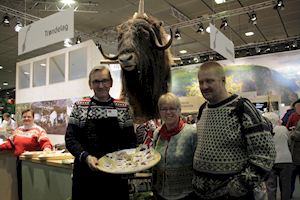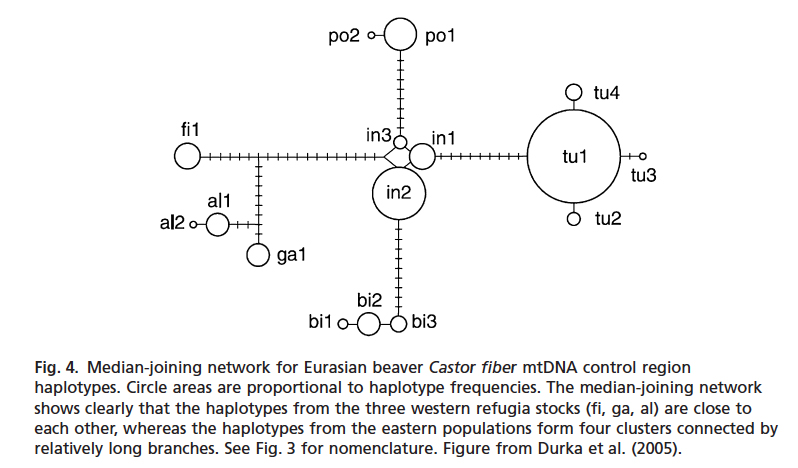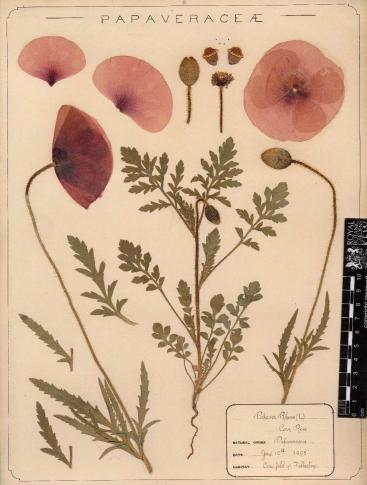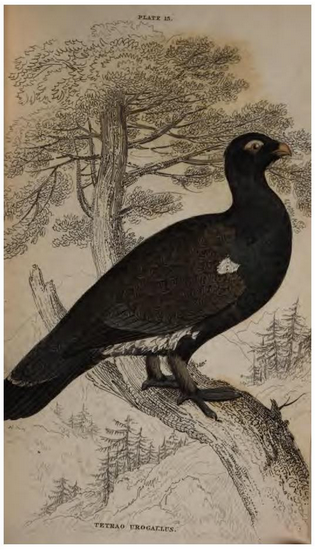
A funny word
I’ve been thinking about the word that I use more often than any other on this blog and my research: reintroduction. It’s an odd word, really.
It’s clearly made up of two parts: “re” meaning to do something again and “introduction” meaning to bring or institute something. Historically, that’s how the word was used. Using Google’s ngrams linked with Google Books, I found that prior to 1850, the word “reintroduction” was used often in political tracts (to reintroduce power structures like royal rule, for example), in religious tracts (to reintroduce a religious practice or Catholicism or papal rule), in architecture (to reintroduce old architectural elements), and in agriculture (to reintroduce a practice that had been discontinued). All of these have in common that they are about cultural practices and elements that were once created by people (i.e. introduced by people) which subsequently declined in use and later are being instituted again (reintroduced). That makes sense — people introduced the practice once upon a time so it can be “re”-introduced.
But what about the use of the word “reintroduction” to mean “the return (a species of animal or plant) to a locality where it was formerly native, with the intention of re-establishing it in the wild” per the Oxford English Dictionary‘s second definitions of reintroduction and reintroduce? How did the word get to mean that? While OED lists their earliest entry as 1890, I was able to trace an earlier use of this type of “reintroduction” via Google Books.
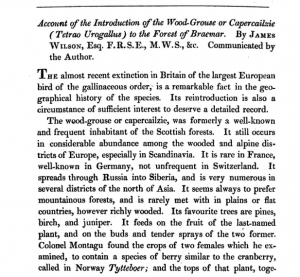
This occurs in an article by James Wilson in 1832 about the return of capercaillie to Scotland. The Western capercaillie (the Scottish way of spelling the name was capercailzie) had been hunted out in Scotland in the late 18th century. In his text, Wilson reports on the first attempt to bring capercaillie back to Scotland using birds from Sweden (Side note: I think it’s awesome that Sweden gets to export reintroduced animals instead of just getting them on this blog!).
Wilson uses the word “reintroduction” once in the article: “Its reintroduction is also a circumstance of sufficient interest to deserve a detailed record.” Yet in the title of the piece he calls it an “Introduction of the Wood-Grouse” and characterizes the activities as attempts “to naturalize it for the second time in Scotland.” According to him, the intention was to raise some chicks by hand then ” liberate a few in the old pine woods of Braemar, and thus eventually to stock with the finest of feathered game the noblest of Scottish forests.” So reintroduction was equal to introduction in the forest, naturalizing for a second time, and stocking.

William Jardin, The Natural History of Game-Birds, Edinburgh, 1834
The most curious of these is “naturalizing it for a second time” because it implies that capercaillie was naturalized once before. Of course, it really was. Capercaillie did not evolve in Scotland – it’s clearly spread throughout Eurasia – so at one time in the distant past it must have migrated there and been “naturalized”. So maybe that’s what Wilson was thinking. In that case, “reintroduction” as a word makes sense in that he would have considered that the bird was “introduced” (albeit by its own movement) into Scotland in the past and could thus be “reintroduced” with human help. Perhaps he just meant “introduction” but wrote it wrong.
In any case, it is fascinating to think about how the word “reintroduction” may have implied prior “introduction” of the species when it was used early on, since now “introduction” is used when people bring a species to an area where it is not native and “reintroduction” is used only when the species is brought back to a place where it was native in the past (like in Seddon 2010).
Wilson publishes several more articles and is quoted in other works in the 1830s and 1840s (for example this one) about the capercaillie reintroduction — and he is the only one I’ve found who uses “reintroduction” with this meaning at that time. Later in the 1800s it would become more regularly used with birds and animals, although I’m not sure if there is a real connection between Wilson’s texts and the later usage. Obviously, this would need much more research to tease out the genealogy of the term.
An alternate word Wilson could have written would have been “restoration” — as in “the restoration of the bird population” — which was the word of choice for John Harvie-Brown in his book Capercaillie in Scotland from 1888. But Wilson didn’t and maybe he invented a new meaning of “reintroduction” in the process. Interestingly, reintroduction rather than restoration becomes the normal term for when individuals of a species are brought from another location to repopulate the area.
Since reintroduction as it is now used doesn’t imply that something is being done again (i.e. the “re” prefix has lost its meaning), can you re-reintroduce? This is actually what may have to happen with the capercaillie in Scotland . The population has experienced a dramatic decline since the 1970s because of climate change and deaths from flying into fences (Moss 2001). According to the latest national survey, there are only about 1200 individuals in Scotland despite conservation attempts (Ewing et al. 2012). The bird, which has prominent symbolic value in Scotland, may not be one people are willing to lose again, so re-reintroduction might be in its future.
